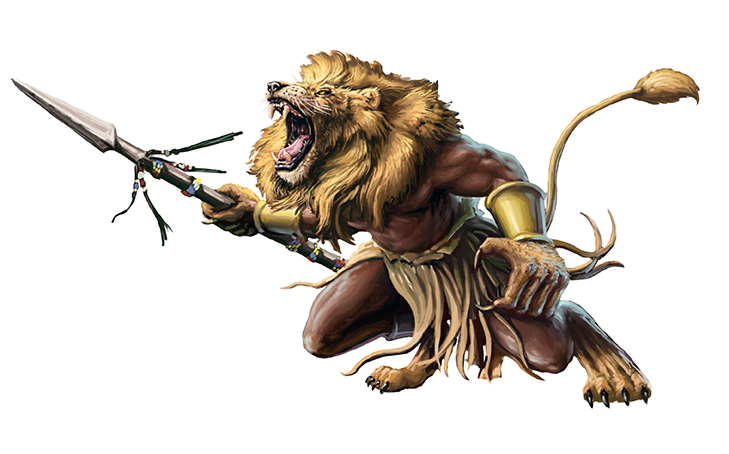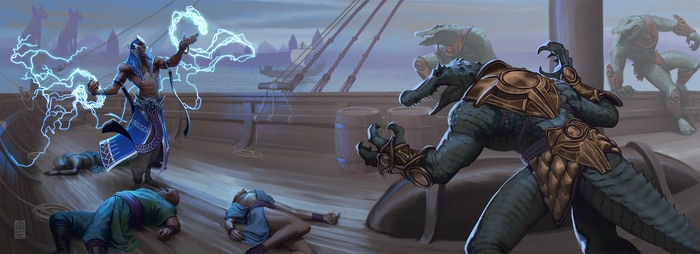
Most 5th Edition players know the Southlands is a vast continent, burgeoning with adventure and mystery. To those who are strong enough to survive its scorching sands and merciless sun, countless riches lie undiscovered among its lost cities and tombs. The trick, of course, is surviving to enjoy that wealth.
For those who call the Southlands home, their survival isn’t just threatened by a brutal desert environment that sprawls across much of its 2,000-mile expanse. They must also contend with vile demonic cults, cursed tombs, and living gods exerting their wills upon them—and that’s just for starters.
To be a cleric in the Southlands means having access to a wide and diverse assortment of gods you can devote your services to. In this article, we’re going to help you choose the perfect deity and domain for your cleric to dedicate themselves to in the Southlands.

Gods of Masks and Mystery
Before we discuss the clerics of the Southlands specifically, it’s important that we first explain how the gods here may differ from other campaign settings.
In the Southlands (and Midgard generally), the deities are not passive beings that stay at rest until their believers call upon them to take action. Instead, the gods have desires and goals of their own and take motivated action to see their schemes come to pass.
In many campaign setting guides, what is written about a deity in the source material is considered the final word. The information presented about a deity explains what they stand for, what symbols represent them, and how their followers should conduct themselves. Players and characters within the world accept what is written as irrefutable, factual, and true. In Midgard, however, that is not the case, and the gods are not always what they seem.
How is such a thing possible? Because the gods of Midgard are eternally locked in a game of deception and power among themselves. Due to a chaotic and strange history that stems as far back as the First Gods, the deities don’t overtly and obviously make their true identities known. Instead, many of the gods in Midgard go by numerous names, are fluid in gender and appearance, and exhibit various domains to their clerics. These are referred to as masks and are explained at length in the Southlands Worldbook in the Pantheon chapter (and are likewise covered in Midgard Worldbook pantheon section).
As you can see, this veil of mystery and uncertainty can shape the way that you approach your character’s personal faith as a cleric. Are you certain you’re serving the deity you believe you are? Only time will tell. Keep this in mind as you choose the cleric you will become in the Southlands.
Your Southlands 5E Cleric Guide
The gods of the Southlands grant their followers access to domains that are rarely found elsewhere. In the section that follows, you’ll find a list of each domain available to you as well as a brief description of how it manifests through your cleric. Additionally, a non-mechanical look at each domain’s Channel Divinity ability is included.
As you read, take note of which clerics pique your interest and then find their full domain write-up (which includes all 5E compatible mechanics) in the Southlands Player’s Guide by Kobold Press.
Cat Domain
This domain allows you to personify the traits of a powerful feline. Imbued with strength, grace, and cunning, you are eventually granted an ability that allows you to literally take on the form of a lion or tiger.
Channel Divinity: Feline Finesse
Add substantial bonuses to Dexterity-based mechanics to yourself or someone near you.
Perfume Domain
There is great power in the scents that we experience, and this domain explores the divine extreme of that principle. This domain is granted by the mighty Bastet, the Queen of Perfumes. Through the powerful aromas of spices and pheromones, you can supernaturally heal and destroy bodies, minds, and souls.
Channel Divinity: Alluring Fragrance
Charm creatures nearby with a powerful, otherworldly fragrance.
Serpent Domain
This domain allows you to become a serpent personified, granting you a measure of stealth, cunning, and even an attack laced with venom. You will learn the nature of shedding your skin and become a creature that is equally powerful and mesmerizing.
Channel Divinity: Serpent Stealth
You and those near you are blessed with the ability to be stealthier for a time.
Speed Domain
Using this domain, you will embody the very essence of speed and agility. As you advance in your faith and learn to master these divine powers, you can eventually manipulate the very fabric of time itself.
Channel Divinity: Burst of Speed
Grant yourself or others the ability to move more quickly and gain increased dexterity for a time.
Vermin Domain
You walk in the knowledge and power that vermin are multitudinous, and there is strength in numbers. You embody creatures such as insects, scorpions, spiders, and rodents, and you are empowered by their traits.
Channel Divinity: Diseased Bite
When you strike your target successfully, there is a time after the initial blow that you deal additional damage by inflicting them with infirmity.
Wind Domain
The winds are wild, primordial, and cannot be tamed. However, through your worship, you have learned to channel them through you. From the calmest zephyr to the most powerful tempest, you are in the service of the wind.
Channel Divinity: Grasp Not the Wind
You become like the wind and are more difficult to keep a grasp on physically. You also gain the ability to fly as though you were the wind itself.
A Quick Cleric Guide (5E)
As you can see, clerics in the Southlands are intrinsically tied to the lore and themes of the land with plenty of domains to choose from. But if this is your first time making a cleric or if you’re reacquainting yourself with the class, here are just a few quick tips to consider during the character creation of your cleric. This isn’t meant to be an exhaustive guide but a tool to get you started on the right foot.
Choose Your Deity Wisely
When speaking of a cleric (DnD 5E clerics especially), you are a servant to a higher power that grants you your divine abilities. This means that the higher power you choose is a major decision. This means you shouldn’t choose a deity for their Divine Domain alone. Also consider what types of things they expect their servants to do and say to be sure it lines up with the character you have in mind.
Your Combat Focus
Clerics are good at casting spells while wearing armor and being able to use their divine power to turn the tide in battle. Keep this in mind as you decide where you want to place your character’s attribute scores. Your spellcasting ability is tied to your Wisdom score, so consider putting your highest score there.
So where should you put your other stats? That depends on the type of cleric you want to play. Here are some notes on how the other ability scores are expressed in combat.
Strength: This is key if you will be in the thick of melee combat.
Dexterity: Focus on this stat if you’ll be fighting at range.
Constitution: This is the source of your hit points, so focus on this for survivability.
If you’re using the standard starting equipment from D&D 5e, you’ll also get an option for a mace or warhammer, as well as a light crossbow. This will allow you to attack both up close in melee combat and at range, so whether you focus on Strength or Dexterity, you’ll have a weapon that suits you.
Cleric Skills
You’ll be able to choose two skills from the following list. The ability score each skill is linked to is listed in parentheses:
- History (Intelligence)
- Insight (Wisdom)
- Medicine (Wisdom)
- Persuasion (Charisma)
- Religion (Intelligence)
If you’re looking to optimize your cleric, consider taking Insight and Medicine since they’re linked to Wisdom (which will most likely be your highest ability score).
Get the Guide to the Southlands
In addition to the cleric domains listed in this article, the Southlands Player’s Guide holds many new options that will allow you to create any character you can dream of. In addition to new races and backgrounds, the book is also loaded with brilliant and unique subclasses, spells, and two new types of magic—lotus and hieroglyphic.
Get your copy today to unlock incredible variety in your character creation.

A good guide for playing for cleric, I have long been looking for something like that, since it is very difficult to figure it out. Thank you!
Before we discuss the clerics of the Southlands specifically, it’s important that we first explain how the gods here may differ from other campaign settings.